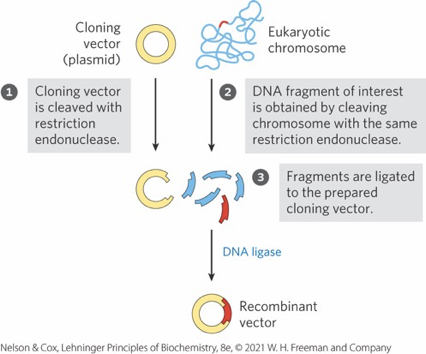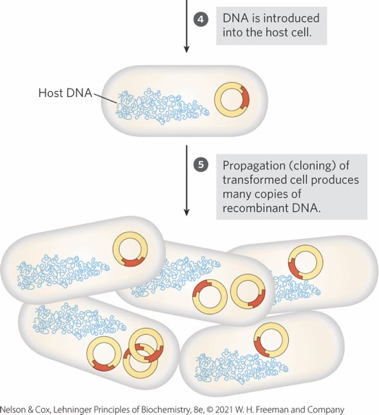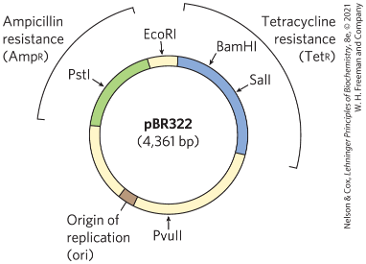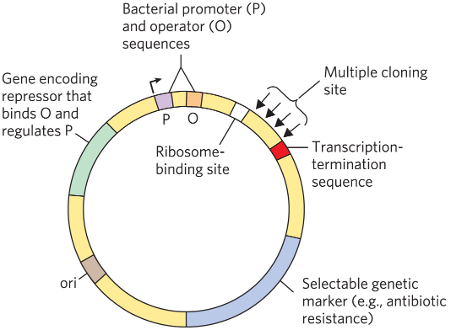Biotechnology Overview: rDNA, Cloning, PCR, and Antibodies
1/74
There's no tags or description
Looks like no tags are added yet.
Name | Mastery | Learn | Test | Matching | Spaced |
|---|
No study sessions yet.
75 Terms
Principles: Genomic information is a resource of unparalleled importance for investigators studying any aspect of biology. Genomes vary in size, but all are large enough to direct all aspects of an organism’s structure and function. To approach them often requires tools to break them into small parts that are experimentally digestible.
An organism’s DNA is the ultimate source of biological information
Advances in DNA sequencing are being matched by new approaches to understanding how chromosomal information is expressed and regulated on a genomic and cellular scale. Important clues to protein function are embedded in the sequences of the genes that encode them.
Genomic information is accessible
We can not only elucidate cellular genomic information; we can also change it. That capacity provides a path to altering any aspect of cellular metabolism, structure, or function.
Genomic information is malleable
the complete set of genes or genetic material present in a cell or organism
Genome
the study of the complete set of DNA (including all of its genes) in a person or other organism
information is a resource of unparalleled importance for investigators studying any aspect of biology
can vary in size, but all are large enough to direct all aspects of an organism’s structure and function
To approach them often requires tools to break them into small parts that are experimentally digestible
Genomics
Considered the basic unit of inheritance
Genes are passed from parents to offspring and contain the information needed to specify physical and biological traits
Gene
non-translated DNA
introns
coding segments of DNA
exons
selective amplification of a particular gene or DNA segment so that its genetic information may be studied and utilized
DNA cloning
the methods used to accomplish DNA cloning and related tasks
Recombinant DNA technology, genetic engineering
The Process of DNA Cloning: Five general processes
Obtain the DNA segment to be cloned
Select a small molecule of DNA capable of autonomous replication
Join the two DNA fragments covalently
Move the recombinant DNA from the test tube to the host organism
Select or identify host cells that contain the recombinant DNA
small DNAs capable of autonomous replication (contain origin of replication)
Cloning vectors

composite DNA molecules comprised of covalently linked segments from 2+ sources
Recombinant DNAs

Restriction Endonucleases and DNA Ligases Yield Recombinant DNA
which enzyme functions to cleave DNA molecules at specific base sequences
Type II Restriction Endonucleases
Restriction Endonucleases and DNA Ligases Yield Recombinant DNA
which enzyme functions to join two DNA molecules or fragments
DNA Ligase
_____ and ______ restriction endonucleases = large, multisubunit complexes containing both endonuclease and methylase activities
Type I, Type III
require no ATP, and catalyze the hydrolytic cleavage of DNA phosphodiester bonds within the recognition sequence
They recognize short, usually palindromic, sequences of 4 to 8 base pairs and, in the presence of Mg2+, cleave the DNA within or in close proximity to the recognition sequence
Type II restriction endonucleases
Restriction Endonucleases Leaves _____
unpaired bases on the ends
Due to endonucleases making staggered cuts
Can base pair with each other or complementary sticky ends
sticky ends
Restriction Endonucleases Leaves _____
no unpaired bases on the ends
Bases stay paired due to endonucleases making straight cuts
blunt ends
_______ Allow Amplification of Inserted DNA Segments
Plasmids
Bacterial artificial chromosomes
Yeast artificial chromosomes
Cloning Vectors
Circular DNA molecule with 5,000 to 400,000 base pairs
Plasmids
Synthetic plasmid cloning vehicle designed to allow simple and rapid preparation of cloned recombinant DNA fragments
Commonly used in E. coli
Key features:
Origin of replication (ori) = sequence where replication is initiated
Resistance genes (contain information for the production of proteins that make antibiotics ineffective)
Recognition sequences for restriction endonucleases
pBR322

laboratory process by which small plasmids are introduced into bacterial cells through heat shock treatment
Reason why is not well understood
Becomes less successful as plasmid size increases
Transformation
laboratory process by which small plasmids are introduced into bacterial cells through high-voltage pulses
Transiently renders the bacterial membrane permeable
Electroporation
A researcher ligates a DNA fragment to pBR322 plasmids, which contain both AmpR and TetR, that were cleaved in the AmpR gene by Pstl. Following ligation and E. coli transformation, colonies with recombinant plasmids will grow on which plates?
Tetracycline plates only
________ Can Be Expressed to Amplify Protein Production
Purified proteins have many purposes:
Elucidating protein function
Studying reaction mechanisms
Generating antibodies to the proteins
Reconstituting complex cellular activities in the test tube with purified components
Examining protein binding partners
Cloned Genes
Expressing a Eukaryotic Protein in a Bacterium
Eukaryotic genes have surrounding sequences needed for their transcription and regulation
____= cloning vectors with transcription and translation signals needed for the regulated expression of a cloned gene
Expression vectors

DNA Sequences in a Typical E. coli Expression Vector
_____ permits regulation by a repressor protein that binds to it
Promoter allows efficient transcription of the inserted gene
Transcription-termination sequence sometimes improves the amount and stability of the mRNA produced
Ribosome-binding site provides sequence signals for the efficient translation of the mRNA derived from the gene
Operator
Many Different Systems Are Used to Express Recombinant Proteins (_______)
In principle, any organism can serve as a host to express proteins from a different species:
Bacteria
Yeast
Insects and insect viruses
Mammalian cells in culture
Expression Systems
Most common hosts for protein expression
Prokaryotes, single-celled microorganisms with no nuclei
Bacteria
Advantages of Using ______ Hosts
Regulatory sequences are well understood
Can express high levels of cloned proteins
Easy to store and grow
Efficient methods for transforming and extracting DNA
can be grown in huge amounts
Bacterial
Disadvantages of Using Bacterial Hosts
Some ______ proteins do not fold correctly
Proteins may not undergo necessary posttranslational modifications or proteolytic cleavage
Some gene sequences can be difficult to express
Many eukaryotic proteins aggregate into insoluble cellular precipitates
heterologous
_________ allow for production of proteins.
Expression vectors
_______________: a process that can turn a single copy of a gene into more than a billion copies in just a few hours
Use of PCR:
making lots of DNA for sequencing
Finding and analyzing DNA from very small samples for use in forensics
Producing numerous copies of genes for genetic engineering
Polymerase Chain Reaction (PCR)
PCR Process
PCR results is “exponential” growth (2n copies, where n = # of cycles)
PCR targets the gene to be copied with primers, single-stranded DNA sequences that are complementary to sequences next to the gene to be copied
To begin PCR, the DNA sample that contains the gene to be copied is combined with primers that frame the gene on both sides
DNA polymerase uses the primers to begin DNA replication and copy the gene; the basic steps of PCR are repeated over and over until you have billions of copies of the DNA sequence between the two primers
___________ used; is a thermostable DNA polymerase
Taq polymerase
typically involves a series of 20 to 40 repeated temperature changes, called cycles, with each cycle usually comprising three discrete temperature shifts:
1. Denaturation
2. Primer annealing (depending on the primer)
3. Primer extension
Polymerase Chain Reaction (PCR)
This type of PCR is preceded by a reaction converting RNA into complementary DNA (cDNA); cDNA contains only exons
The resulting cDNA is used as a template for a second conventional PCR
The technique is widely used in the detection of RNA viruses and to study gene expression
Reverse Transcriptase PCR (RT-PCR)
PCR-based technique that couples amplification of a target DNA sequence with quantification of the concentration of that DNA species in the reaction
Uses fluorescent dye and fluorometer
Enables calculation of the starting template concentration and is therefore a frequently used analytical tool
Quantitative PCR (qPCR)
glycoproteins belonging to the immunoglobulin (Ig) superfamily that are secreted by B cells to identify and neutralize foreign organisms or antigens
contain two heavy and two light chains and are grouped into different isotypes dependent on which type of heavy chain they contain
Antibodies (Abs)
The fragment antigen binding (Fab) portions of the antibody determine its specificity and enable the binding of antigen
The fragment crystallizable (Fc) portion is responsible for its biological activity; this biological activity depends on interactions between the Fc portion and Fc receptors (FcR) or complement proteins
This region allows antibodies to activate the immune system
IgG Structure
Antigenic determinant
The portion of an antigen that makes contact with a particular antibody
Epitope
The part of an antibody which recognizes and binds to an antigen
paratope
_______ antibodies refer to a homogenous population of antibodies, which are produced by a single clone of plasma B cells
They bind to only one epitope on a specific antigen
low cross reactivity
Expensive to produce
Monoclonal
________ antibodies refer to a heterogenous mixture of immunoglobulin molecules, which are secreted against a particular antigen; produced by multiple clones of plasma B cells
Each antibody recognizes different epitopes on the same antigen
Increased likelihood of cross reactivity
Less expensive to produce
Polyclonal
Mechanisms of Action of _______
Antibodies mediate their actions by various types of direct or indirect effects
1. Direct modulation of target antigen
2. Fc binds to Fcγ receptors resulting in antibody-dependent cellular cytotoxicity (ADCC)
3. Fc binds to complement protein resulting in complement-dependent cytotoxicity (CDC)
4. Delivery of a cytotoxic agent (drug, radioisotope, toxin)
mAbs

In 1975 _____ and ________ were the first to describe the in vitro production of murine mAbs from hybridomas; hybridomas are immortal antibody-secreting cell lines
Kohler, Milstein
In an attempt to overcome the inherent immunogenicity and reduced effector function of murine mAbs, chimeric mouse-human antibodies (suffix: -_________) were developed
This was enabled by grafting the entire antigen-specific variable domain of a mouse Ab onto the constant domains of a human Ab using genetic engineering techniques, resulting in molecules that are approximately 65% human
These chimeric mAbs exhibit an extended half-life and show reduced immunogenicity, but nevertheless, the propensity of chimeric mAbs to induce anti-drug antibodies is still considerable
ximab
To further improve mAb properties, humanized mAbs (suffix: -________) were developed by grafting just the murine hypervariable regions onto a human Ab framework, resulting in molecules that are approximately 95% human
While humanized mAbs appeared to overcome the inherent immunogenic problems of murine and chimeric mAbs, humanization does have limitations and can be a laborious process
The advent of in vitro phage display technology and the generation of various transgenic mouse strains expressing human variable domains enabled the generation of fully human mAbs (suffix: -umab)
Both humanized and fully human mAbs have significantly reduced immunogenic potential and show properties similar to human endogenous IgGs
zumab
Types of mAbs (monoclonal antibodies)
Murine
omab
Types of mAbs (monoclonal antibodies)
Chimeric
ximab
Types of mAbs (monoclonal antibodies)
Humanized
zumab
Types of mAbs (monoclonal antibodies)
Human
umab
__________ are used for diagnosis, disease treatment and research
have been used to treat the following conditions:
Cancer
Organ transplant rejection
Inflammatory and autoimmune disorders, including allergies
Infections, including COVID-19
Osteoporosis
Eye conditions
Migraines
High cholesterol
Nervous system disorders
Monoclonal antibodies
§Monoclonal antibodies are given mostly as _________ solution via infusion
intravenous (IV)
One of the most common methods used to produce mAbs
In this process, antibody-producing B lymphocytes are isolated from mice after immunizing the mice with a specific antigen and are fused with immortal myeloma cell lines to form hybrid cells, called hybridoma cells
These hybridoma cells are cultured in a lab to produce mAbs
Antibodies produced are of high purity and are highly sensitive and specific
Hybridoma Technology

Mice that have had DNA from another source put into their DNA; the foreign DNA is put into the nucleus of a fertilized mouse egg and the new DNA becomes part of every cell and tissue of the mouse
Transgenic Mice
Xenomouse
A transgenic technology
Antibody-producing B cells, isolated from the spleen of an immunized Xenomouse, are used to produce hybridomas
Fully human mAbs are produced through the use of hybridoma technology
________ (Vectibix), the first therapeutic mAb developed by this transgenic technology was approved by the FDA in 2006 for the treatment of advanced colorectal cancer
Panitumumab
The approval and market introduction of human ______, produced by recombinant technique in Escherichia coli (E. coli), in 1982, represented an important milestone in the field of protein therapeutics
insulin
As therapeutics, they are predominantly used to bind target antigens, which can then block specific signaling pathways or induce cell death; they can also serve as vehicles for the targeted delivery of potent cytotoxic drugs to diseased cells
Antibodies
As therapeutics, they can be delivered to replace a deficient or absent enzyme in enzyme replacement therapy; in other cases, they can be used as agents to catalyze the degradation, cleavage, or chemical modification of therapeutically relevant targets
Enzymes
As therapeutics, these proteins can be plasma-derived or produced recombinantly and administered to patients with a deficiency in native levels
Coagulation factors
Common Classes of Protein-based Therapeutics
antibodies, enzymes, coagulation factors, protein hormones, cytokines
Act as chemical messengers by binding to receptors which then trigger a signaling cascade and lead to a physiological response; insulin represents a classic example
Protein hormones
Encompasses molecules such as interleukins, interferons, and colony-stimulating factors that mediate cell-to-cell communication during immune responses; this contrasts with protein hormones, which largely regulate the endocrine system
can be used as immunomodulatory agents for a variety of indications, including multiple sclerosis and leukemia
Cytokines
Protein Stability
Understanding stability implies knowing the mechanisms that lead to instability of the protein drug
Leads to determining factors influencing the “shelf life” or stability of the protein drug
Thus, the study of protein stability in essence is the study of factors/pathways that lead to protein instability
Protein instability can be classified into two major categories:
Chemical instability, Physical instability
Making or breaking covalent bonds resulting in a new chemical entity
Types of chemical modification:
Hydrolysis
Side chain hydrolysis - Deamidation
Peptide bond hydrolysis - Proteolysis (fragmentation)
Oxidation
Racemization
Disulfide exchange reactions
chemical instability
Involves structural changes that are independent of chemical modifications
Types of physical instability:
Denaturation
Aggregation
Precipitation
Surface Adsorption
Physical Instability
Most proteins in native state are globular
Proteins fold (adopt globular structure) to reduce the exposure of hydrophobic groups to the surrounding environment
i.e., Hydrophobic amino acids are generally inside while hydrophilic amino acids are on the surface of the protein
The loss of globular structure (unfolding) of a protein is termed _______
Caused by various factors including heat, pH changes, etc.
Denatured proteins generally result in loss of biological activity
denaturation
Self-association of protein molecules resulting in the formation of dimers, trimers, tetramers, etc. and macromolecular intermediates
Partially unfolded proteins (through denaturation) can lead to ______
increases the likelihood of adverse immunogenic effects
Increases patient morbidity and mortality
Loss of biological function of the protein; thus, reducing efficacy
Imparts turbidity to solution or physical separation
may be reversible and _ may be soluble
aggregation
The extreme form of aggregation (macroscopic aggregation)
It is irreversible, and the protein is partially or completely unfolded
Not all insoluble protein material is due to aggregation (e.g., salting-out effect)
Salted-out proteins still retain activity and native-like structure and the _____ is fully reversible upon dilution
precipitation
Adhesion of proteins to surfaces
Proteins can adhere to the walls of the vial by surface adsorption and can “flocculate or frost” leading to problems in bio-equivalence (dose delivered)
Surface-induced protein instability begins with:
Adsorption of either native or partially unfolded protein on the surface
Surface tension forces at various interfaces can drive aggregation by affecting structural integrity of protein molecules
Desorption of partially unfolded proteins from the surface can lead to nucleation and growth of aggregates in the bulk solution
Surface Adsorption
One Way to Improve Protein Stability – ________ (Freeze-drying
Removal of moisture (solvent) from a frozen product under vacuum
Essentially, it is low temperature dehydration process, which involves freezing the product, lowering the pressure, then removing the ice by sublimation
Occurs in three stages:
Freezing
Primary drying
Secondary drying
Reactions that can occur to the product in the liquid phase such as hydrolysis, cross-linking, oxidation, aggregation, and disulfide rearrangement are essentially eliminated when the product is frozen dried
Freeze drying is also advantageous because the dry product has a very high specific surface area, which leads to a rapid and complete redissolution
Lyophilization
Lyophilization, Step 1. Freezing
Generation of ice-water interface
Proteins can denature at the ice-water interface
________ - Excipients used to protect the protein from stresses during freezing
E.g., Disaccharides (sucrose), glycerol, and polyethylene glycol (PEG)
Cryoprotectants
Lyophilization, Step 2. Primary Drying
The ice formed during freezing is removed by ______ at sub-ambient temperatures under vacuum
Typically carried out at chamber pressures of 40-400 Torr and shelf temperatures ranging from –30 to 10 °C
sublimation
Lyophilization, Step 3. Secondary Drying
Relatively small amount of bound water remaining in the matrix is removed by _______
During this stage, the temperature of the shelf and product are increased to promote adequate desorption rates and achieve the desired residual moisture
Removal of water during drying stages can cause destabilization of the protein structure
Lyoprotectants (e.g., sucrose, trehalose) can act as water substitute and form H-bonding with the proteins and stabilize during drying
Lyoprotectants also form glasses of extremely high viscosity; the drug and water molecules are immobilized in the viscous glass, leading to extremely high activation energies required for any reactions to occur
desorption